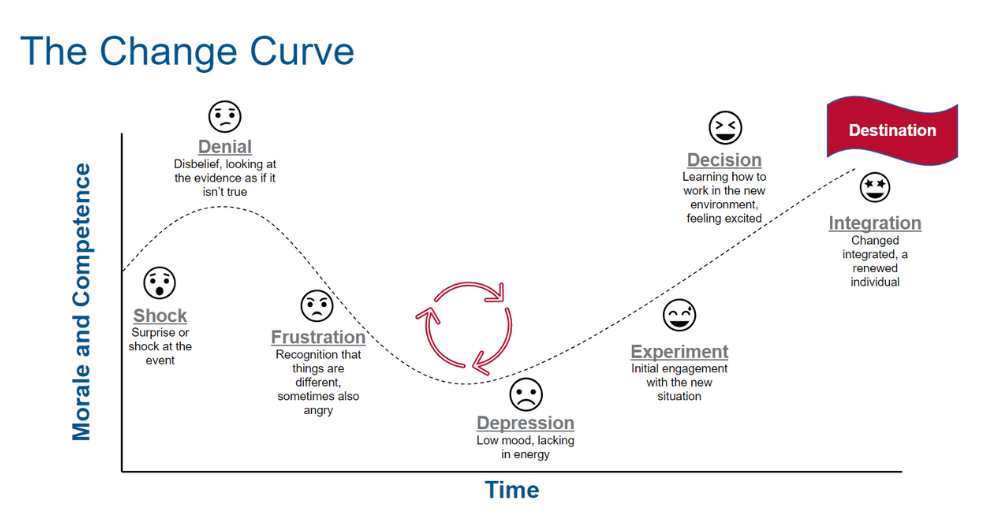The holidays are over, and it’s time to get back to business. Post Christmas can feel like a hangover for many business owners – overload, motivation lag, and depressive moments like Blue Monday can leave you feeling distracted and isolated.
However, embracing some of the core lessons around the change curve and intentional goal-setting can help transform the post-holiday slump into an opportunity to set your business up for success in 2024. In this blog, we’ll explore how to navigate from the holiday hangover to a place of focus and purpose to achieve your most ambitious business goals this year.
What is The Change Curve?
The change curve is a model that describes the emotional and psychological stages individuals go through when faced with change. Developed by psychiatrist Elisabeth Kubler-Ross in the 1960s to explain the stages of grief, the change curve has been adapted and widely used in organisational psychology to understand how people react to and cope with significant changes in the workplace.

Shock Stage: Handling the Full Inbox
Coming back from your time off to a mountain of emails, stacked-up projects, and lingering holiday expenses can be shocking. You may feel overwhelmed and unsure of where to even start coming out of time away.
The key here is to set expectations on what can realistically be achieved by you and your team in the early weeks of January. Our top tips to do this are to:
- Recognise that capacity may be lower for people adjusting back to work rhythms.
- Establish priority areas rather than trying to tackle everything at once.
- Communicate with staff and clients that January will focus on regaining momentum on vital initiatives first.
Once core foundations are reinstated, you’ll be better equipped to handle mounting inboxes and new demands.
Denial Stage: Avoid Extending the Holiday Mindset
With seasonal affective disorder and cold weather dragging on motivation, it can be tempting to remain in a vacation mindset for January. You may be inclined to push off business development goals, delay major projects until later quarters, and generally resist fully engaging. Here it’s vital to embrace January as a month just as important as any other on the calendar.
Set some foundational objectives, activities, and meetings to restart key areas like sales, marketing campaigns, or new product development. Use January to solidify core elements of initiatives you hope will gain traction later in Q1 and beyond. Having these building blocks in place will enable you to hit the ground running once motivation levels rise.
Depression Stage: Recognising the Blue Monday Struggle
The third Monday in January, known as Blue Monday, can be a challenging time for many in the workforce. The excitement of the holidays has passed, dark winter days stretch ahead, and motivation often dips.
As a leader, recognising the potential impact of this post-holiday slump is key. Expect that productivity may lag in mid-January as energy levels plummet. Set realistic goals that account for possible dips in drive and morale. Offer compassion and flexibility, emphasising self-care and work-life balance. Leverage your support systems to boost morale. A little grace and understanding during this time can go a long way. With some care and adjustment, teams can rally through the post-holiday lull.
Acceptance Stage: Get Your Team Aligned on 2024 Goals
Once the January fog has lifted, it’s time to get focused on what needs to happen this year. Gather your leadership team to figure out your company KPIs for 2024.
Book some time in to plan measurable objectives for the year ahead. Make sure they filter down appropriately into department targets and individual KPIs that will drive daily priorities. Equipping your crew with this sense of purpose and clarity around the key benchmarks for growth can work wonders to blast away any January disengagement.
Motivation is restored when everyone is in agreement about where you’re going and how you’ll map out your progress. During the acceptance stage, it’s important to come to a realistic consensus about what success in the upcoming year looks like. Define it, and your team will help make it happen.
Integration Stage: Channel Blue Monday Insights Into Q1 Planning
Finally, use the reflections and insights gleaned from navigating the January productivity lows and Blue Monday to inform your Q1 planning. What part of your customer journey or internal processes struggled due to the post-holiday hangover? How can you implement change to be resilient regardless of seasonal fluxes and motivation downturns?
Many leading organisations do their annual and quarterly goal setting based on the lessons learned by pushing through the most challenging period of January. They emerge more focused, strategic, and connected to their “why” – efforts aligned to growth outcomes necessary to power through future holidays and seasons.
The post-holiday highs and January lows will always be part of the business journey. But by harnessing the change curve and insights from the Blue Monday period, you can set your business up to accomplish tremendous growth goals over the course of 2024.
Needing some help?
The post-holiday slump can dampen motivation, but with strategic planning, January can set the stage for growth.
ActionCOACH provides training for business leaders on strategy, leadership, and goal-setting to drive organisations forward. Contact us today.





